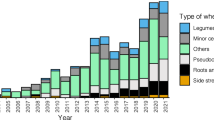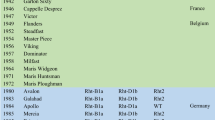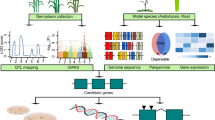Abstract
Despite their economic importance and growing demand, concerns are emerging around wheat-based foods and human health. Most wheat-based foods are made from refined white flour rather than wholemeal flour, and the overconsumption of these products may contribute to the increasing global prevalence of chronic diseases, particularly type 2 diabetes and obesity. Here, we review how the amount, composition and interactions of starch and cell wall polysaccharides, the major carbohydrate components in refined wheat products, impact human health. We discuss strategies and challenges to manipulate these components for improved diet and health using newly developed wheat genomics tools and resources. Commercial foods developed from these novel approaches must be produced without adverse effects on cost, consumer acceptability and processing properties.
This is a preview of subscription content, access via your institution
Access options
Access Nature and 54 other Nature Portfolio journals
Get Nature+, our best-value online-access subscription
$29.99 / 30 days
cancel any time
Subscribe to this journal
Receive 12 digital issues and online access to articles
$119.00 per year
only $9.92 per issue
Buy this article
- Purchase on Springer Link
- Instant access to full article PDF
Prices may be subject to local taxes which are calculated during checkout




Similar content being viewed by others
References
FAOSTAT Crops (Food and Agriculture Organization of the United Nations); http://www.fao.org/faostat/en/#data/QC
Mattei, J. et al. Reducing the global burden of type 2 diabetes by improving the quality of staple foods: the Global Nutrition and Epidemiologic Transition Initiative. Glob. Health 11, 23 (2015).
FAOSTAT New Food Balances (Food and Agriculture Organization of the United Nations); http://www.fao.org/faostat/en/#data/FBS
Shewry, P. R. & Hey, S. The contribution of wheat to human diet and health. Food Energy Secur. 4, 178–202 (2015).
Andersson, A. A. M. et al. Contents of dietary fibre components and their relation to associated bioactive components in whole grain wheat samples from the HEALTHGRAIN diversity screen. Food Chem. 136, 1243–1248 (2013).
Brouns, F. J. P. H., van Buul, V. J. & Shewry, P. R. Does wheat make us fat and sick? J. Cereal Sci. 58, 209–215 (2013).
Davis, W. R. Wheat Belly: Lose the Wheat, Lose the Weight, and Find Your Path Back to Health (Rodale Books, 2011).
EFSA Panel on Dietetic Products, Nutrition and Allergies (NDA). Scientific opinion on the substantiation of health claims related to resistant starch and reduction of post-prandial glycaemic responses (ID 681), “digestive health benefits” (ID 682) and “favours a normal colon metabolism” (ID 783) pursuant to Article 13(1) of Regulation (EC) No 1924/2006. EFSA J. 9, 2024 (2011).
Aune, D. et al. Whole grain consumption and risk of cardiovascular disease, cancer, and all cause and cause specific mortality: systematic review and dose-response meta-analysis of prospective studies. BMJ 353, i2716 (2016).
Brownlee, I. A., Durukan, E., Masset, G., Hopkins, S. & Tee, E.-S. An overview of whole grain regulations, recommendations and research across Southeast Asia. Nutrients 10, 752 (2018).
Seal, C. J. & Brownlee, I. A. Whole-grain foods and chronic disease: evidence from epidemiological and intervention studies. Proc. Nutr. Soc. 74, 313–319 (2015).
Shao, Y. et al. Reduction of falling number in soft white spring wheat caused by an increased proportion of spherical B-type starch granules. Food Chem. 284, 140–148 (2019).
Park, S.-H., Wilson, J. D. & Seabourn, B. W. Size granule distribution of hard red winter and hard red spring wheat: its effects on mixing and breadmaking quality. J. Cereal Sci. 49, 98–105 (2009).
Chia, T. et al. A carbohydrate-binding protein, B-GRANULE CONTENT 1, influences starch granule size distribution in a dose-dependent manner in polyploid wheat. J. Exp. Bot. 71, 105–115 (2020).
The definition of dietary fiber. Cereal Foods World 46, 112–126 (2001); http://www.cerealsgrains.org/initiatives/definitions/Documents/DietaryFiber/DFDef.pdf
Haska, L., Nyman, M. & Andersson, R. Distribution and characterisation of fructan in wheat milling fractions. J. Cereal Sci. 48, 768–774 (2008).
Loosveld, A.-M. A. et al. Structural variation and levels of water-extractable arabinogalactan-peptide in European wheat flours. Cereal Chem. 75, 815–819 (1998).
Murphy, M. M., Douglass, J. S. & Birkett, A. Resistant starch intakes in the United States. J. Am. Diet. Assoc. 108, 67–78 (2008).
Corrado, M. et al. Effect of semolina pudding prepared from starch branching enzyme IIa and b mutant wheat on glycaemic response in vitro and in vivo: a randomised controlled pilot study. Food Funct. 11, 617–627 (2020).
Edwards, C. H. et al. Manipulation of starch bioaccessibility in wheat endosperm to regulate starch digestion, postprandial glycemia, insulinemia, and gut hormone responses: a randomized controlled trial in healthy ileostomy participants. Am. J. Clin. Nutr. 102, 791–800 (2015).
Ahuja, G., Jaiswal, S. & Chibbar, R. N. in Resistant Starch 1–22 (John Wiley and Sons, 2013).
Franco, C. M. L., do Rio Preto, S. J. & Ciacco, C. F. Factors that affect the enzymatic degradation of natural starch granules: effect of the size of the granules. Starch 11, 422–426 (1992).
Bathgate, G. N., Clapperton, J. F. & Palmer, G. H. The significance of small starch granules. In Proc. Eur. Brew. Conv. Congr. Salzburg 183–186 (Elsevier, 1973).
Lovegrove, A. et al. Role of polysaccharides in food, digestion and health. Crit. Rev. Food Sci. Nutr. 57, 237–253 (2015).
Aguilera, J. M. The food matrix: implications in processing, nutrition and health. Crit. Rev. Food Sci. Nutr. 59, 3612–3629 (2019).
Chen, C. et al. Therapeutic effects of soluble fibre consumption on type 2 diabetes mellitus. Exp. Ther. Med. 12, 1232–1242 (2016).
Botticella, E. et al. Combining mutations at genes encoding key enzymes involved in starch synthesis affects the amylose content, carbohydrate allocation and hardness in the wheat grain. Plant Biotech. J. 16, 1723–1734 (2018).
Gouseti, O. et al. Exploring the role of cereal dietary fibre in digestion. J. Agric. Food Chem. 67, 8419–8424 (2019).
International Wheat Genetics Sequencing Consortium (IWGSC). Shifting the limits in wheat research and breeding using a fully annotated reference genome. Science 361, eaar7191 (2018).
10+ Wheat Genomes Project The Wheat ‘Pan Genome’ (Wheat Initiative, 2011); http://www.10wheatgenomes.com/
Krasileva, K. V. et al. Uncovering hidden variation in polyploid wheat. Proc. Natl Acad. Sci. USA 114, E913–E921 (2017).
Ramirez-Gonzalez, R. H., Uauy, C. & Caccamo, M. PolyMarker: a fast polyploid primer design pipeline. Bioinformatics 31, 2038–2039 (2015).
Ramirez-Gonzalez, R. H. et al. The transcriptional landscape of polyploid wheat. Science 361, eaar6089 (2018).
Borrill, P., Ramirez-Gonzalez, R. & Uauy, C. expVIP: a customizable RNA-seq data analysis and visualisation platform. Plant Physiol. 170, 2172–2186 (2016).
Borrill, P., Harrington, S. A. & Uauy, C. Applying the latest advances in genomics and phenomics for trait discovery in polyploid wheat. Plant J. 97, 56–72 (2019).
Harrington, S. A., Backhaus, A. E., Singh, A., Hassani-Pak, K. & Uauy, C. The wheat GENIE3 network provides biologically-relevant information in polyploid wheat. G3 Genes Genomes Genetics https://doi.org/10.1534/g3.120.401436 (2020).
Arora, A. et al. Resistance gene cloning from a wild crop relative by sequence capture and association genetics. Nat. Biotechnol. 37, 139–143 (2019).
Wingen, L. et al. Wheat landrace genome diversity. Genetics 205, 1657–1676 (2017).
Zhang, Y. et al. Efficient and transgene-free genome editing in wheat through transient expression of CRISPR/Cas9 DNA or RNA. Nat. Commun. 7, 12617 (2016).
Yamamori, M., Kato, M., Yui, M. & Kawasaki, M. Resistant starch and starch pasting properties of a starch synthase IIa-deficient wheat with apparent high amylose. Aust. J. Agric. Res. 57, 531–535 (2006).
Hazard, B. et al. Mutations in durum wheat SBEII genes affect grain yield components, quality, and fermentation responses in rats. Crop Sci. 55, 2813–2825 (2015).
Regina, A. et al. A genetic strategy generating wheat with very high amylose content. Plant Biotech. J. 13, 1276–1286 (2015).
Schönhofen, A., Zhang, X. & Dubcovsky, J. Combined mutations in five wheat STARCH BRANCHING ENZYME II genes improve resistant starch but affect grain yield and bread-making quality. J. Cereal Sci. 75, 165–174 (2017).
Borrill, P., Adamski, N. & Uauy, C. Genomics as the key to unlocking the polyploid potential of wheat. New Phytol. 208, 1008–1022 (2015).
Chia, T. et al. Transfer of a starch phenotype from wild wheat to bread wheat by deletion of a locus controlling B-type starch granule content. J. Exp. Bot. 68, 5497–5509 (2017).
Howard, T. et al. Identification of a major QTL controlling the content of B-type starch granules in Aegilops. J. Exp. Bot. 62, 2217–2228 (2011).
Toole, G. A. et al. Spectroscopic analysis of diversity of arabinoxylan structures in cell walls of wheat cultivars (Triticum aestivum) in the HEALTHGRAIN diversity collection. J. Agric. Food Chem. 59, 7075–7082 (2011).
Scheller, H. V. & Ulvskov, P. Hemicelluloses. Annu. Rev. of Plant Biol. 61, 263–289 (2010).
Ward, J. et al. The HEALTHGRAIN cereal diversity screen: concept, results and prospects. J. Agric. Food Chem. 56, 9699–9709 (2008).
Shewry, P. R. et al. Improving wheat as a source of dietary fibre for human health. Proc. Nutr. Soc. Summer Meeting 74, E87 (Cambridge University Press, 2015).
Lovegrove, A. et al. Identification of a major QTL and associated marker for high arabinoxylan fibre in white wheat flour. PLoS ONE 15, e0227826 (2020).
Lockyer, S. & Nugent, A. P. Health effects of resistant starch. Nutr. Bull. 42, 10–41 (2017).
Mishra, A., Singh, A., Sharma, M., Kumar, P. & Roy, J. Development of EMS-induced mutation population for amylose and resistant starch variation in bread wheat (Triticum aestivum) and identification of candidate genes responsible for amylose variation. BMC Plant Biol. 16, 217 (2016).
Acknowledgements
Rothamsted Research, the John Innes Centre (JIC), NIAB and Quadram Institute Bioscience (QIB) receive grant-aided support from the Biotechnology and Biological Sciences Research Council (BBSRC) of the UK. The work at Rothamsted, the JIC and NIAB forms part of the Designing Future Wheat strategic programme (BB/P016855/1) and Molecules from Nature programme (BBS/E/J/000PR9799) and the work at QIB part of the Food Innovation and Health strategic programme (BB/R012512/1) and its constituent projects BBS/E/F/000PR10343 (Theme 1, Food Innovation) and BBS/E/F/000PR10345 (Theme 2, Digestion in the Upper GI Tract).
Author information
Authors and Affiliations
Contributions
All authors contributed to writing the article.
Corresponding author
Ethics declarations
Competing interests
The authors declare no competing interests.
Additional information
Publisher’s note Springer Nature remains neutral with regard to jurisdictional claims in published maps and institutional affiliations.
Rights and permissions
About this article
Cite this article
Hazard, B., Trafford, K., Lovegrove, A. et al. Strategies to improve wheat for human health. Nat Food 1, 475–480 (2020). https://doi.org/10.1038/s43016-020-0134-6
Received:
Accepted:
Published:
Issue Date:
DOI: https://doi.org/10.1038/s43016-020-0134-6
This article is cited by
-
A multi-omic resource of wheat seed tissues for nutrient deposition and improvement for human health
Scientific Data (2023)
-
Combatting Fusarium head blight: advances in molecular interactions between Fusarium graminearum and wheat
Phytopathology Research (2022)
-
Loss of starch synthase IIIa changes starch molecular structure and granule morphology in grains of hexaploid bread wheat
Scientific Reports (2022)
-
A stealth health approach to dietary fibre
Nature Food (2022)



